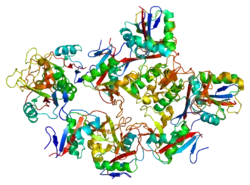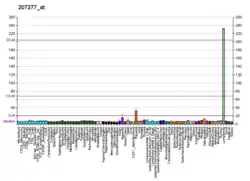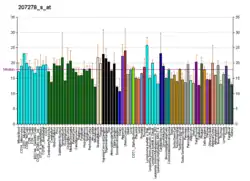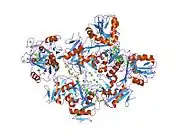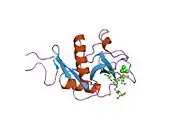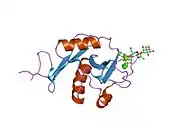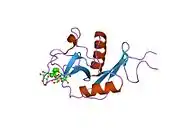DC-SIGN
DC-SIGN که مخفف عبارت «Dendritic Cell-Specific Intercellular adhesion molecule-3-Grabbing Non-integrin» به معنای «مولکول غیر اینتگرینی چسبندگی دریافتگر ۳ اختصاصی سلولهای دندریتیک» است و با نام CD209 هم شناخته میشود، یک پروتئین است که در انسان توسط ژن «CD209» کُدگذاری میشود.[4]
این مولکول یک گیرندهٔ لکتین نوع سی است که بر روی ماکروفاژها و سلولهای دندریتیک یافت میشود. این مولکول اگر بر سطح ماکروفاژها باشد، قادر به تشخیص و اتصال به کربوهیدراتهای نوع مانوز است که نوعی الگوی ملکولی وابسته به پاتوژن هستند که در ویروسها، باکتریها و قارچها موجودند. در اثر این اتصال، بیگانهخواری تحریک میشود.[5] اگر این مولکول بر سطح سلولهای دندریتیک باشد، کارش تنظیم تعاملهای این سلولها با لایه درونرگی و فعالسازی لنفوسیتهای تی و همچنین تشخیص هاپتنهای بیماریزاست.
منابع
- GRCm38: Ensembl release 89: ENSMUSG00000040197 - Ensembl, May 2017
- "Human PubMed Reference:". National Center for Biotechnology Information, U.S. National Library of Medicine.
- "Mouse PubMed Reference:". National Center for Biotechnology Information, U.S. National Library of Medicine.
- Curtis BM, Scharnowske S, Watson AJ (September 1992). "Sequence and expression of a membrane-associated C-type lectin that exhibits CD4-independent binding of human immunodeficiency virus envelope glycoprotein gp120". Proc. Natl. Acad. Sci. U.S.A. 89 (17): 8356–60. doi:10.1073/pnas.89.17.8356. PMC 49917. PMID 1518869.
- McGreal E, Miller J, Gordon S (2005). "Ligand recognition by antigen-presenting cell C-type lectin receptors". Curr Opin Immunol. 17 (1): 18–24. doi:10.1016/j.coi.2004.12.001. PMID 15653305.
- مشارکتکنندگان ویکیپدیا. «DC-SIGN». در دانشنامهٔ ویکیپدیای انگلیسی، بازبینیشده در ۲۵ دسامبر ۲۰۱۹.
برای مطالعهٔ بیشتر
- Geijtenbeek TB, Engering A, Van Kooyk Y (2002). "DC-SIGN, a C-type lectin on dendritic cells that unveils many aspects of dendritic cell biology". J. Leukoc. Biol. 71 (6): 921–31. PMID 12050176.
- Baribaud F, Doms RW, Pöhlmann S (2006). "The role of DC-SIGN and DC-SIGNR in HIV and Ebola virus infection: can potential therapeutics block virus transmission and dissemination?". Expert Opin. Ther. Targets. 6 (4): 423–31. doi:10.1517/14728222.6.4.423. PMID 12223058.
- Bénichou S, Benmerah A (2003). "[The HIV nef and the Kaposi-sarcoma-associated virus K3/K5 proteins: "parasites"of the endocytosis pathway]". Med Sci (Paris). 19 (1): 100–6. doi:10.1051/medsci/2003191100. PMID 12836198.
- van Kooyk Y, Geijtenbeek TB (2003). "DC-SIGN: escape mechanism for pathogens". Nat. Rev. Immunol. 3 (9): 697–709. doi:10.1038/nri1182. PMID 12949494.
- Turville S, Wilkinson J, Cameron P, et al. (2004). "The role of dendritic cell C-type lectin receptors in HIV pathogenesis". J. Leukoc. Biol. 74 (5): 710–8. doi:10.1189/jlb.0503208. PMID 12960229.
- Cambi A, Figdor CG (2004). "Dual function of C-type lectin-like receptors in the immune system". Curr. Opin. Cell Biol. 15 (5): 539–46. doi:10.1016/j.ceb.2003.08.004. PMID 14519388.
- Joseph AM, Kumar M, Mitra D (2005). "Nef: "necessary and enforcing factor" in HIV infection". Curr. HIV Res. 3 (1): 87–94. doi:10.2174/1570162052773013. PMID 15638726.
- Stove V, Verhasselt B (2006). "Modelling thymic HIV-1 Nef effects". Curr. HIV Res. 4 (1): 57–64. doi:10.2174/157016206775197583. PMID 16454711.
- Ortiz M, Kaessmann H, Zhang K, Bashirova A, Carrington M, Quintana-Murci L, Telenti A (2008). "The evolutionary history of the CD209 (DC-SIGN) family in humans and non-human primates". Genes Immun. 9 (6): 483–492. doi:10.1038/gene.2008.40. PMC 2701223. PMID 18528403.
- Becer CR, Gibson MI, Geng J, Ilyas R, Wallis R, Mitchell D, Haddleton DM (2010). "High-Affinity Glycopolymer Binding to Human DC-SIGN and Disruption of DC-SIGN Interactions with HIV Envelope Glycoprotein". J. Am. Chem. Soc. 132 (43): 15130–15132. doi:10.1021/ja1056714. PMC 3091610. PMID 20932025.
پیوند به بیرون
- DC-SIGN در سرعنوانهای موضوعی پزشکی (MeSH) در کتابخانهٔ ملی پزشکی ایالات متحدهٔ آمریکا
